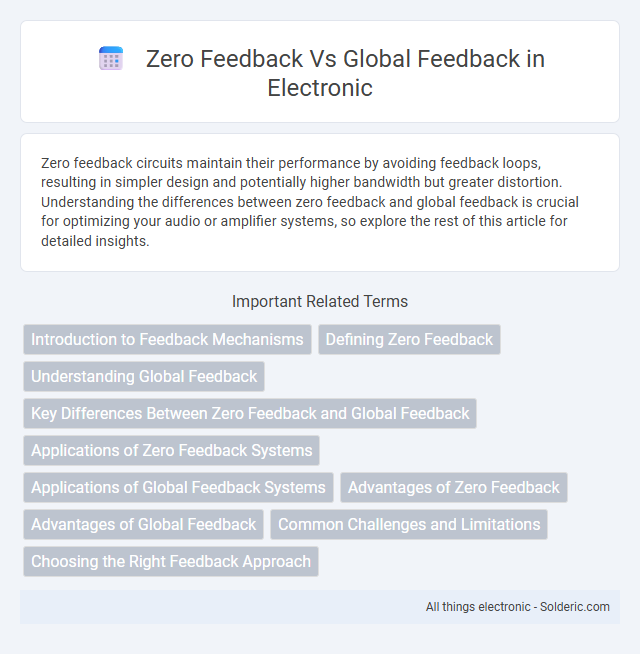Zero feedback circuits maintain their performance by avoiding feedback loops, resulting in simpler design and potentially higher bandwidth but greater distortion. Understanding the differences between zero feedback and global feedback is crucial for optimizing your audio or amplifier systems, so explore the rest of this article for detailed insights.
Comparison Table
| Feature | Zero Feedback | Global Feedback |
|---|---|---|
| Definition | No feedback applied in the system or amplifier design. | Feedback taken from the overall output to control the input. |
| Stability | Less stable, prone to oscillations. | Improved stability across operating conditions. |
| Distortion | Higher harmonic distortion due to no correction. | Reduced distortion via feedback correction. |
| Bandwidth | Limited bandwidth performance. | Extended bandwidth by flattening frequency response. |
| Noise | Higher noise levels. | Lower noise due to feedback suppression. |
| Gain Control | Fixed gain determined by components. | Gain stabilized and controlled through feedback loop. |
| Complexity | Simple design, fewer components. | More complex circuitry due to feedback paths. |
Introduction to Feedback Mechanisms
Zero feedback amplifiers operate without returning any portion of the output signal to the input, resulting in high gain but potentially increased distortion and instability. Global feedback applies a fraction of the output back to the input over the entire amplifier circuit, enhancing linearity, bandwidth, and reducing distortion. Understanding these feedback mechanisms is crucial for optimizing amplifier performance in audio and electronic signal processing applications.
Defining Zero Feedback
Zero feedback in amplifier design refers to a configuration where the output signal is not fed back to the input to control gain or stability, resulting in inherently higher distortion and less predictable frequency response. This technique contrasts with global feedback, which employs feedback loops encompassing the entire amplifier circuit to reduce distortion and improve linearity. Zero feedback amplifiers often offer simpler designs and faster transient response but sacrifice the low distortion and enhanced stability achievable through global feedback mechanisms.
Understanding Global Feedback
Global feedback in amplifier design improves performance by feeding a portion of the output signal back to the input, stabilizing gain and reducing distortion. Unlike zero feedback circuits, which operate without feedback loops and often exhibit higher distortion and less predictable gain, global feedback enhances linearity and bandwidth. This technique is essential for achieving consistent amplification in audio and signal processing applications, leading to improved sound fidelity and operational stability.
Key Differences Between Zero Feedback and Global Feedback
Zero feedback amplifiers rely solely on the inherent properties of the transistor or tube without connecting the output back to the input, resulting in simpler design but higher distortion and limited bandwidth. Global feedback involves routing a portion of the output signal back to the input to control gain, reduce distortion, and improve frequency response and stability. Understanding these key differences helps you choose the appropriate amplification method based on your desired performance and complexity requirements.
Applications of Zero Feedback Systems
Zero feedback systems are widely applied in radio frequency (RF) amplifiers to enhance stability and maintain gain consistency without the complexity of feedback loops. They are preferred in high-frequency applications such as oscillators and microwave amplifiers where feedback can cause undesirable phase shifts and oscillations. Additionally, zero feedback designs simplify circuit architecture, making them suitable for sensor amplifiers and audio preamplifiers where low distortion and noise performance are critical.
Applications of Global Feedback Systems
Global feedback systems are widely used in high-fidelity audio amplifiers to enhance linearity and reduce distortion across the entire output stage, making them ideal for professional sound equipment and broadcast systems. These systems also improve stability and bandwidth in operational amplifiers utilized in precision instrumentation and control systems. In power electronics, global feedback enables efficient regulation and response in switched-mode power supplies and motor control drives, ensuring optimal performance under varying load conditions.
Advantages of Zero Feedback
Zero feedback amplifiers offer advantages such as improved stability and simpler design, minimizing the risk of oscillations caused by feedback loops. They provide faster transient responses and lower noise since no feedback path alters the signal, ensuring a cleaner output. Your audio systems benefit from the natural tonal characteristics preserved without the coloration sometimes introduced by global feedback.
Advantages of Global Feedback
Global feedback in amplifier circuits enhances overall stability and reduces distortion by feeding a portion of the output signal back to the input, improving linearity and bandwidth. It minimizes gain variability caused by device parameter changes and temperature shifts, resulting in more consistent performance. This feedback mechanism also lowers noise levels and increases the amplifier's dynamic range, delivering higher fidelity in audio and signal processing applications.
Common Challenges and Limitations
Zero feedback amplifiers often face challenges like limited bandwidth and increased distortion due to the absence of corrective loops, leading to less stable performance under varying load conditions. Global feedback circuits improve linearity and bandwidth but can introduce issues such as phase shifts and potential oscillations, limiting their effectiveness at high frequencies. Both types may suffer from noise and reduced dynamic range, requiring careful design considerations to balance gain, stability, and fidelity.
Choosing the Right Feedback Approach
Selecting the appropriate feedback approach hinges on the desired amplifier performance; zero feedback offers simplicity and faster transient response but may suffer from higher distortion and reduced stability. Global feedback, applied around the entire amplifier, enhances linearity and reduces distortion, improving overall sound quality while potentially introducing complexity and stability challenges. Balancing these trade-offs requires evaluating the application's requirements for fidelity, stability, and design complexity.
Zero feedback vs Global feedback Infographic

 solderic.com
solderic.com